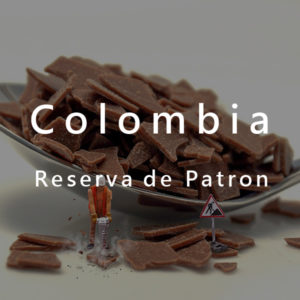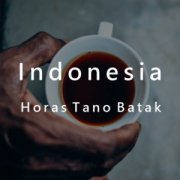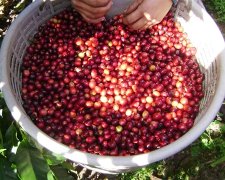Introduction to Reserva del Patron Coffee, a model student of La Minita Manor in Raminita, Colombia

For professional baristas, please follow the coffee workshop (Wechat official account cafe_style)
La Minita Manor Series, Model Raw Coffee (Reserva del Patron) comes from Narino province, the southernmost province of Colombia, carefully selects small estates or farms in the Narino region, and manually selects the best quality and Supremo grade raw coffee beans. As a result of these strict screening mechanisms, the annual output of model raw coffee is only about 6000 packets of coffee, accounting for only about 4% of the Narino producing areas (the whole Nanino province produces about 150000 packets of coffee per year) These coffee beans are the essence of Narino producing areas, and the processing process is strictly monitored by La minita's Costa Rican European Standard (Costa Rican Europrep standards). The quality is excellent and stable.
The geographical environment of Raminita Manor
Hacienda La Minita Manor is located in the famous Tarrazu producing area of Costa Rica. Due to its excellent geographical environment and microclimate, the beans of La Minita Manor have a more balanced and fragrant taste than coffee from other Tarrazu producing areas.
Of the 1200 acres of La Minita's total cultivated area, 680acres are currently under cultivation, with the remaining 200acres in the south as a natural forest reserve forbidden to grow coffee trees, while the estate is planted in an east-west direction, facing the Tarrazu River to the south and the Alumbre River to the north, the two rivers meet on the western ridge where the manor is located, and the soil is gray, yellowish-brown and reddish clay rich in organic matter. Some areas of the manor reach a height of 1830 meters, but the height of the central region falls between 1250 and 1650 meters.
Although there are differences in altitude and temperature, fortunately, the large river around the manor reduces the cooling benefits, and the farm faces to the west and can slowly heat up in the morning and cool slowly in the evening. It is also because this unique geographical environment has formed unique advantages.
Coffee Tree species and planting in Raminita Manor
Four varieties of coffee trees, Caturra, Caturra red, Caturra yellow and Hibridoru, were planted in La Minita Manor in about 680 acres. After years of experimental statistical analysis and cup quality test, La Minita Manor decided to mainly adopt Caturra varieties and continue to retain a small number of old Hibrido varieties. Although La Minita planted about 2500 coffee trees per acre, the number of coffee trees was still determined according to geographical characteristics and coffee species. La minita Manor currently has a total of about 1.7 million trees. La Minita adopts a five-year knockout system. Every five years, the previously produced coffee trees are cut to a height of about 50 centimeters, leaving lower branches. This practice will stimulate the rebirth of the trees. After a year of cutting down trees, two main twigs will be selected for production in the next four years. These processes are all carried out manually, with about 350000 trees trimmed each year. After three rounds of pruning, that is, 15 years, the resources of the coffee trees are almost exhausted. La Minita will move new trees from his own coffee nursery instead. The nursery is located in a well-protected place in the manor. The new trees planted in the nursery will be planted in the nursery for a year before being transplanted to the production farm. Under normal circumstances, La Minita will plant about 150000 coffee trees a year. In addition, La Minita uses fast-growing and wide-leaved "Pror" trees as coffee shade trees, which will choose different planting densities according to the demand for sunlight and temperature control in the production area, and will be adjusted according to the demand.
All the soils in the manor are tested twice a year and decide how to fertilize the soil based on the above-mentioned test results. La Minita Manor is very careful when using products that increase production, fertilizing about three times a year for economic and environmental considerations and reasons. In addition, spraying some trace elements such as zinc, boron and copper on the back of the leaves can provide more nutrients and prevent diseases.
In La Minita Manor, pesticides are not used, and fortunately, the climate and altitude formed by the geographical advantages of the estate greatly limit the number of pests. Most importantly, through careful planting and weeding techniques, the coffee trees planted by La Minita are strong and healthy, and a few pests do not have much impact on the coffee trees. At the end of the rainy season, cherry fruit ripens, green cherry fruit begins to turn red or yellow, cherry fruit ripens very slowly and unevenly, not as fast and consistent as flowering. Therefore, the harvest work must be handled more carefully. The ripe cherry fruit will be harvested first, and the immature fruit will be left on the tree for harvest later. The fruit of a coffee tree will be harvested up to five times by La minita due to maturity, and the production season will end after the last harvest, around the end of February. After the production season, all the coffee fruits, whether ripe or immature, are picked to prepare the coffee trees for production in the coming year.
Country: Colombia
Product name: Raminita model student
Production area: Narino
Grade: Supremo
Particle size: Super-Supremo-18 mesh
Treatment: washing
Altitude: 1600-2200 m
Variety: Borbon, Caturra, Typica
Important Notice :
前街咖啡 FrontStreet Coffee has moved to new addredd:
FrontStreet Coffee Address: 315,Donghua East Road,GuangZhou
Tel:020 38364473
- Prev

Lintong producing area of Lindong, Sumatra, Indonesia, Blue Lake (Blue Batak) Manning Blue Eye Manning
Professional barista communication please pay attention to the coffee workshop (Wechat official account cafe_style) Blue Lake Batak in Lindong Province is less than two hours' drive from Medan, the largest city in North Sumatra, a famous volcanic lake, it is the world's largest volcanic lake, the hinterland is very large, so the characteristic style of coffee from the north to the east will be very large, and this blue Bhatta
- Next

Introduction to Kuma Mill of Cesar Cubs processing Farm in Magdalena District of Madalina, Colombia
For the exchange of professional baristas, please follow the Coffee Workshop (Wechat official account cafe_style) Columbia Cesar Majagua Tipica Washed. To the west of Colombia is the Andes, divided into three parts: the western, central and eastern mountains. The Cauca and Magdalena rivers flow along the Caribbean to the lowland plains. Colombia is currently the second largest coffee maker in the world.
Related
- Detailed explanation of Jadeite planting Land in Panamanian Jadeite Manor introduction to the grading system of Jadeite competitive bidding, Red bid, Green bid and Rose Summer
- Story of Coffee planting in Brenka region of Costa Rica Stonehenge Manor anaerobic heavy honey treatment of flavor mouth
- What's on the barrel of Blue Mountain Coffee beans?
- Can American coffee also pull flowers? How to use hot American style to pull out a good-looking pattern?
- Can you make a cold extract with coffee beans? What is the right proportion for cold-extracted coffee formula?
- Indonesian PWN Gold Mandrine Coffee Origin Features Flavor How to Chong? Mandolin coffee is American.
- A brief introduction to the flavor characteristics of Brazilian yellow bourbon coffee beans
- What is the effect of different water quality on the flavor of cold-extracted coffee? What kind of water is best for brewing coffee?
- Why do you think of Rose Summer whenever you mention Panamanian coffee?
- Introduction to the characteristics of authentic blue mountain coffee bean producing areas? What is the CIB Coffee Authority in Jamaica?

